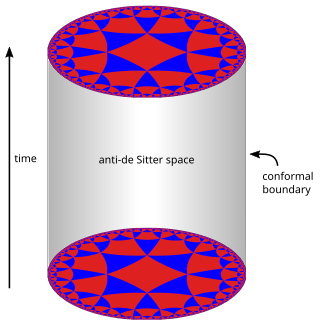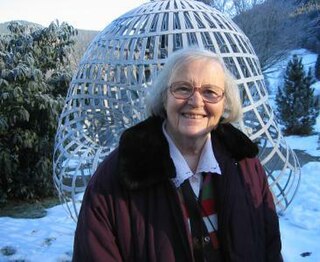The weak and the strong cosmic censorship hypotheses are two mathematical conjectures about the structure of gravitational singularities arising in general relativity.

In mathematical physics, Minkowski space combines inertial space and time manifolds with a non-inertial reference frame of space and time into a four-dimensional model relating a position to the field.
In mathematical physics, a closed timelike curve (CTC) is a world line in a Lorentzian manifold, of a material particle in spacetime, that is "closed", returning to its starting point. This possibility was first discovered by Willem Jacob van Stockum in 1937 and later confirmed by Kurt Gödel in 1949, who discovered a solution to the equations of general relativity (GR) allowing CTCs known as the Gödel metric; and since then other GR solutions containing CTCs have been found, such as the Tipler cylinder and traversable wormholes. If CTCs exist, their existence would seem to imply at least the theoretical possibility of time travel backwards in time, raising the spectre of the grandfather paradox, although the Novikov self-consistency principle seems to show that such paradoxes could be avoided. Some physicists speculate that the CTCs which appear in certain GR solutions might be ruled out by a future theory of quantum gravity which would replace GR, an idea which Stephen Hawking labeled the chronology protection conjecture. Others note that if every closed timelike curve in a given space-time passes through an event horizon, a property which can be called chronological censorship, then that space-time with event horizons excised would still be causally well behaved and an observer might not be able to detect the causal violation.
In differential geometry, a pseudo-Riemannian manifold, also called a semi-Riemannian manifold, is a differentiable manifold with a metric tensor that is everywhere nondegenerate. This is a generalization of a Riemannian manifold in which the requirement of positive-definiteness is relaxed.
The Penrose–Hawking singularity theorems are a set of results in general relativity that attempt to answer the question of when gravitation produces singularities. The Penrose singularity theorem is a theorem in semi-Riemannian geometry and its general relativistic interpretation predicts a gravitational singularity in black hole formation. The Hawking singularity theorem is based on the Penrose theorem and it is interpreted as a gravitational singularity in the Big Bang situation. Penrose was awarded the Nobel Prize in Physics in 2020 "for the discovery that black hole formation is a robust prediction of the general theory of relativity", which he shared with Reinhard Genzel and Andrea Ghez.

In mathematics and physics, n-dimensional anti-de Sitter space (AdSn) is a maximally symmetric Lorentzian manifold with constant negative scalar curvature. Anti-de Sitter space and de Sitter space are named after Willem de Sitter (1872–1934), professor of astronomy at Leiden University and director of the Leiden Observatory. Willem de Sitter and Albert Einstein worked together closely in Leiden in the 1920s on the spacetime structure of the universe. Paul Dirac was the first person to rigorously explore anti-de Sitter space, doing so in 1963.
A Tipler cylinder, also called a Tipler time machine, is a hypothetical object theorized to be a potential mode of time travel—although results have shown that a Tipler cylinder could only allow time travel if its length were infinite or with the existence of negative energy.
The Gödel metric, also known as the Gödel solution or Gödel universe, is an exact solution, found in 1949 by Kurt Gödel, of the Einstein field equations in which the stress–energy tensor contains two terms: the first representing the matter density of a homogeneous distribution of swirling dust particles, and the second associated with a negative cosmological constant.
In the mathematical field of Lorentzian geometry, a Cauchy surface is a certain kind of submanifold of a Lorentzian manifold. In the application of Lorentzian geometry to the physics of general relativity, a Cauchy surface is usually interpreted as defining an "instant of time". In the mathematics of general relativity, Cauchy surfaces provide boundary conditions for the causal structure in which the Einstein equations can be solved
In general relativity, a congruence is the set of integral curves of a vector field in a four-dimensional Lorentzian manifold which is interpreted physically as a model of spacetime. Often this manifold will be taken to be an exact or approximate solution to the Einstein field equation.
In mathematical physics, global hyperbolicity is a certain condition on the causal structure of a spacetime manifold. It is called hyperbolic in analogy with the linear theory of wave propagation, where the future state of a system is specified by initial conditions. This is relevant to Albert Einstein's theory of general relativity, and potentially to other metric gravitational theories.
Misner space is an abstract mathematical spacetime, first described by Charles W. Misner. It is also known as the Lorentzian orbifold . It is a simplified, two-dimensional version of the Taub–NUT spacetime. It contains a non-curvature singularity and is an important counterexample to various hypotheses in general relativity.

The causal sets program is an approach to quantum gravity. Its founding principles are that spacetime is fundamentally discrete and that spacetime events are related by a partial order. This partial order has the physical meaning of the causality relations between spacetime events.
In mathematical physics, the causal structure of a Lorentzian manifold describes the causal relationships between points in the manifold.

Spacetime topology is the topological structure of spacetime, a topic studied primarily in general relativity. This physical theory models gravitation as the curvature of a four dimensional Lorentzian manifold and the concepts of topology thus become important in analysing local as well as global aspects of spacetime. The study of spacetime topology is especially important in physical cosmology.

Yvonne Choquet-Bruhat is a French mathematician and physicist. She has made seminal contributions to the study of Einstein's general theory of relativity, by showing that the Einstein equations can be put into the form of an initial value problem which is well-posed. In 2015, her breakthrough paper was listed by the journal Classical and Quantum Gravity as one of thirteen 'milestone' results in the study of general relativity, across the hundred years in which it had been studied.
In general relativity, Synge's world function is a smooth locally defined function of pairs of points in a smooth spacetime with smooth Lorentzian metric . Let be two points in spacetime, and suppose belongs to a convex normal neighborhood of so that there exists a unique geodesic from to included in , up to the affine parameter . Suppose and . Then Synge's world function is defined as:
In the theory of causal structure on Lorentzian manifolds, Geroch's theorem or Geroch's splitting theorem gives a topological characterization of globally hyperbolic spacetimes.
In gravitation theory, a world manifold endowed with some Lorentzian pseudo-Riemannian metric and an associated space-time structure is a space-time. Gravitation theory is formulated as classical field theory on natural bundles over a world manifold.

The theory of causal fermion systems is an approach to describe fundamental physics. It provides a unification of the weak, the strong and the electromagnetic forces with gravity at the level of classical field theory. Moreover, it gives quantum mechanics as a limiting case and has revealed close connections to quantum field theory. Therefore, it is a candidate for a unified physical theory. Instead of introducing physical objects on a preexisting spacetime manifold, the general concept is to derive spacetime as well as all the objects therein as secondary objects from the structures of an underlying causal fermion system. This concept also makes it possible to generalize notions of differential geometry to the non-smooth setting. In particular, one can describe situations when spacetime no longer has a manifold structure on the microscopic scale. As a result, the theory of causal fermion systems is a proposal for quantum geometry and an approach to quantum gravity.































